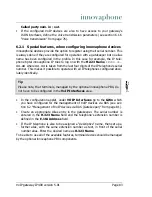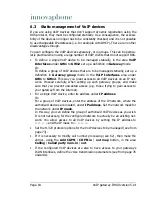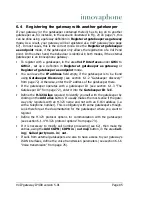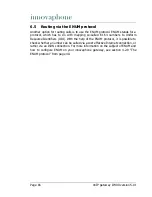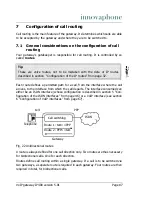
VoIP gateway IP400 version 5.01
Page 97
the prefix entered above. It usually does not make any sense to make any
replacements here. The same sequence of digits is then specified as under
Calling number in
.
• Leave the remaining fields empty.
I you have set automatic correction of all calling numbers (see section 7.2.2
“Automatic correction of all calling numbers” from page 95) the check applies to
numbers already corrected.
Fig. 26 on page 91 shows such a configuration.
If you delete the
CGPN Mappings
, make absolutely certain that you deactivate
the
Verify CGPN
checkbox, since otherwise no calling number at all would be
allowed, making the
Map
ineffective.
7.2.4 Changing the calling party number for specific routes
In some case it can be useful to modify the calling party numbers for calls routed
with the aid of specific
Maps
. Proceed here in accordance with the relevant
descriptions under section 7.2.1 “Manipulation of the calling number (CLI)” from
page 94.
Make certain in this case that the
Verify CGPN
checkbox is not activated. Note
also that, during the execution of a route, the interpretation of calling numbers is
always independent of the type of address (see section 5.2.7 “Dealing with the
various ISDN address types” from page 62), with the effect that no address types
can be specified here.
7.2.5 Defining call number replacements
It often makes sense to replace dial prefixes generally and independent of indi-
vidual routes, for instance to implement abbreviated dialling. Here the abbrevi-
ated dialling number is replaced by the complete number and then routing is per-
formed again for the now complete number.
This can be achieved by defining a route to the destination
MAP
in the
Default
call destination
field. After the number replacement, the call is not connected
in the usual way but a suitable
Map
is searched for in the routing table with the
replaced call number.
Please note that, in order to avoid endless replacement operations, only those
routes after the MAP route (text-wise) are searched through. MAP routes must
thus always be specified before the routes that define the treatment of the
replaced number.

